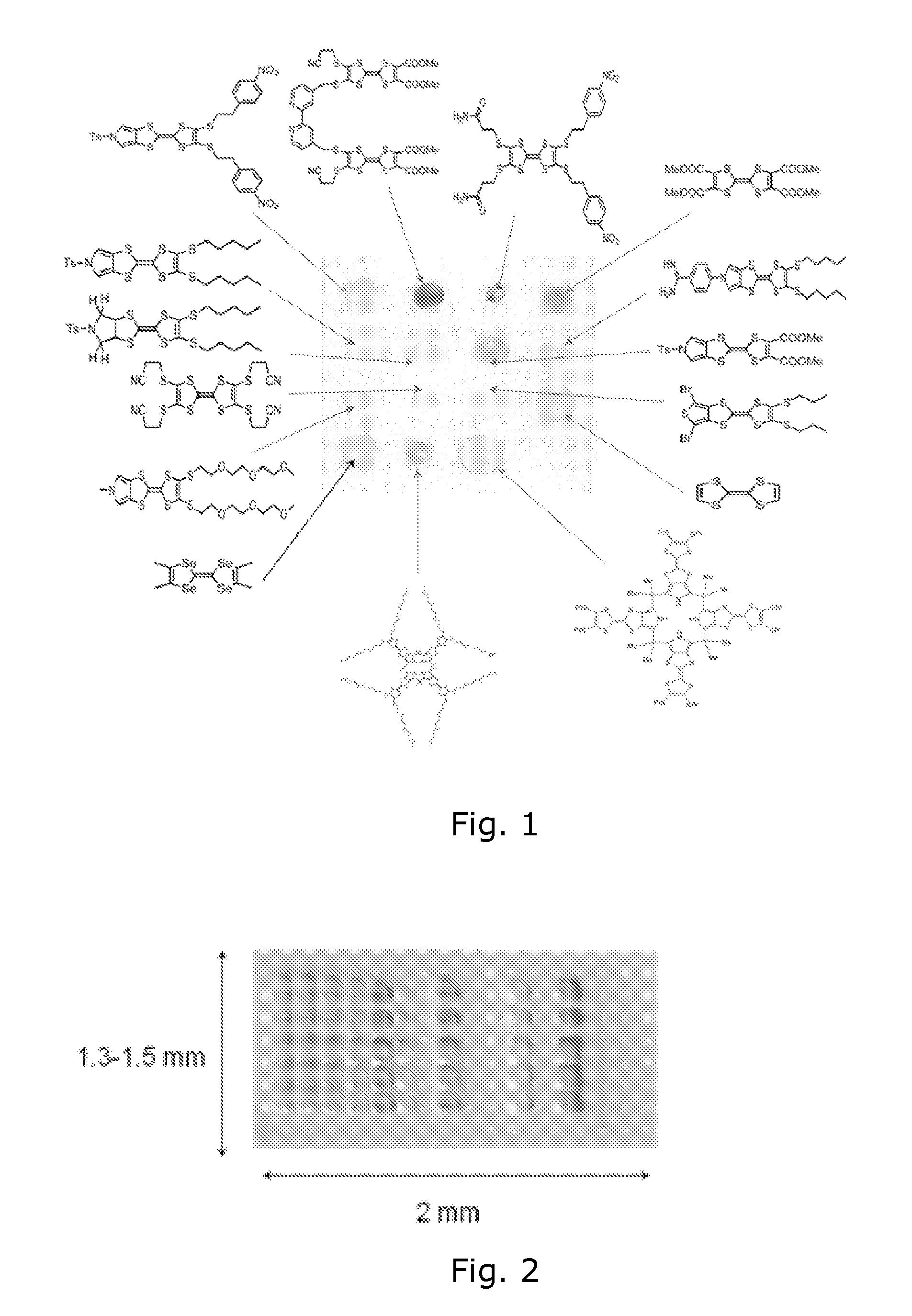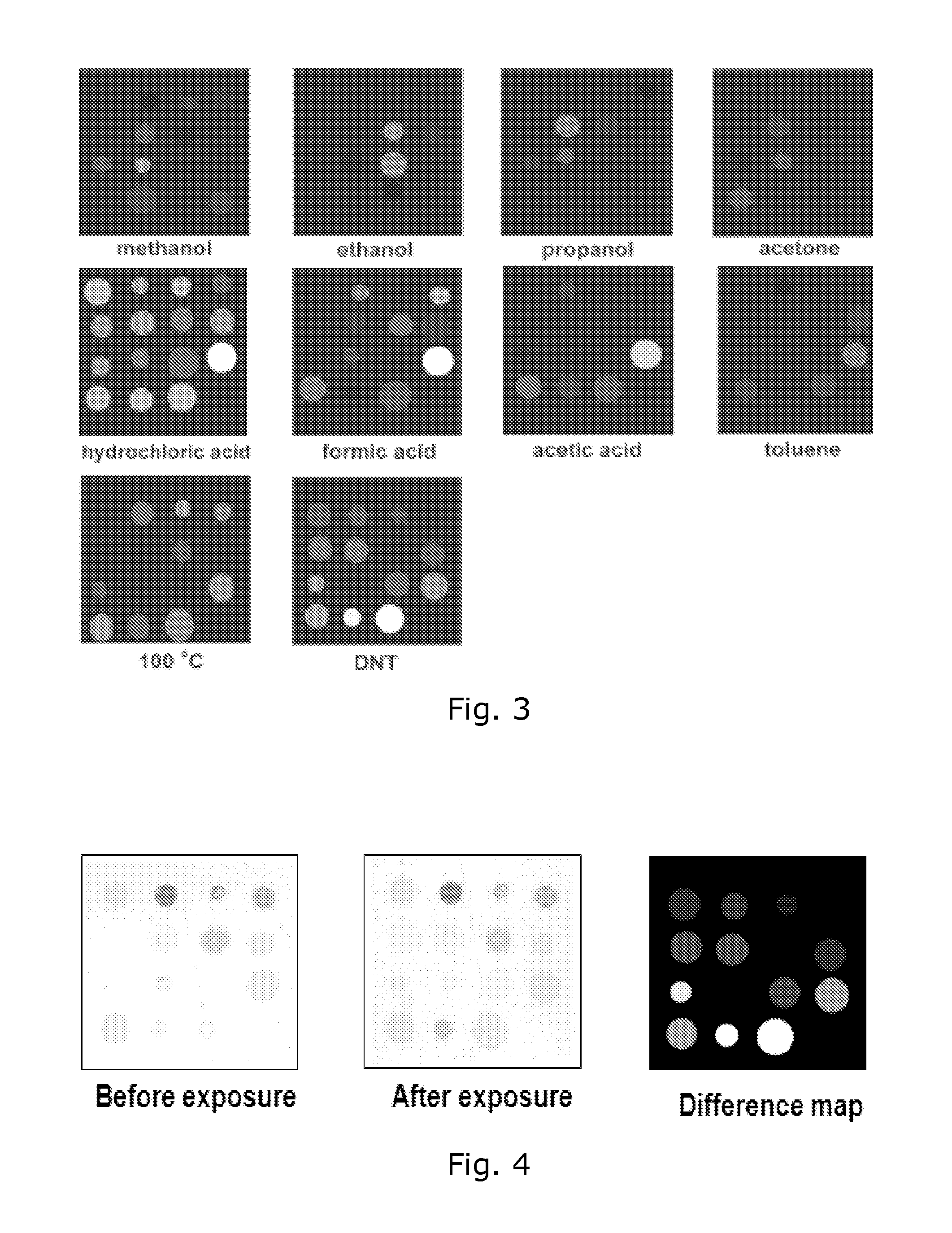Multisensor array for detection of analytes or mixtures thereof in gas or liquid phase
a technology of analytes and multisensor arrays, applied in the field of multisensor arrays for detection of analytes, can solve the problems of difficult to move into new locations where detection is difficult, technical equipment can be rather heavy, and the chemical diversity of the above-mentioned metalated or non-metalated porphyrine and its derivatives is relatively limited
- Summary
- Abstract
- Description
- Claims
- Application Information
AI Technical Summary
Benefits of technology
Problems solved by technology
Method used
Image
Examples
example 1
Preparation of Sensor Array by Hand
[0155]Compounds 1-15 from the list of compounds in Table 1 were chosen. To prepare the sensor array, the chemo-selective compounds with given numbers 6, 8, 10, 13 and 15 were dissolved in 1,2-dichlorobenzene (Sigma, St. Louis, USA), and chemo-selective compounds with given numbers 1-5, 7, 9, 11, 12 and 14 were dissolved in DMSO (Sigma, St. Louis, USA) to obtain a final concentration of 1% (w / v). Stock solutions of the compounds were stored in brown flasks at room temperature. Immediately after preparation of the solutions, the chemo-selective compounds were immobilized on a solid support (Kieselgel 60F254, Merck KGaA, Germany). Position and structure of compounds, are shown in FIG. 1. The volume of applied chemo-selective compounds was 1 μL per spot. Each individual spot was approximately 1.5 mm in diameter with the total size of the sensor array of approximately 2.5 cm×2.5 cm. Pictures were scanned through an ordinary flatbed scanner (Epson V750-M...
example 2
Preparation of the Sensor Array by Micro-Spotting
[0156]The 15 solutions of the compounds described in Example 1 were used to prepare a miniaturized sensor array using a micro-contact spotting Spotbot2 instrument (Arrayit, Sunnyvale, Calif., USA) with a mounted SMP3 pin. Spot spacing was 150 μm. The pin has a flat surface, defined uptake channel which allows loading of 0.25 μL of a sample and produces spots of 110 μm in diameter. The solid support used here were both Kieselgel 60F254 membrane (Merck KGaA, Germany) and a nitrocellulose membrane (Schleicher & Schuell, Dassel, Germany). The volume per spot was not determined (a delivery volume of 600 pL was expected on a microscope slide surface). Pictures of the printed microarray were obtained by using an Olympus stereomicroscope with a mounted Olympus colored camera (Olympus, Center Valley, Pa., USA). FIG. 2 shows the results of the printed sensor array on a nitrocellulose membrane before exposure to analytes. Each spot was approxima...
example 3
Use of Different Solid Supports
[0157]Different solid supports were used to prepare the sensor array according to the invention: Kieselgel 60F254 plates (Merck KGaA, Germany, PVDF membranes with hydrophilic properties (Millipore Corporation, Billerica, Mass., USA), nitrocellulose membranes (Schleicher&Schuell, Dassel, Germamy), polypropylene, polyester, nitrocellulose mixed ester, nylon, polyethersulfone, Teflon membranes, and glass fiber were from Stelitech (Sterlitech Corporation, Kent, Wash., USA). Chemo-selective compounds were manually deposited directly onto the solid support or deposited by using the micro-spotting technique as described in Example 1 and Example 2, respectively. FIG. 2 shows the micro-spotting experiments using nitrocellulose membrane.
PUM
 Login to View More
Login to View More Abstract
Description
Claims
Application Information
 Login to View More
Login to View More - R&D
- Intellectual Property
- Life Sciences
- Materials
- Tech Scout
- Unparalleled Data Quality
- Higher Quality Content
- 60% Fewer Hallucinations
Browse by: Latest US Patents, China's latest patents, Technical Efficacy Thesaurus, Application Domain, Technology Topic, Popular Technical Reports.
© 2025 PatSnap. All rights reserved.Legal|Privacy policy|Modern Slavery Act Transparency Statement|Sitemap|About US| Contact US: help@patsnap.com



